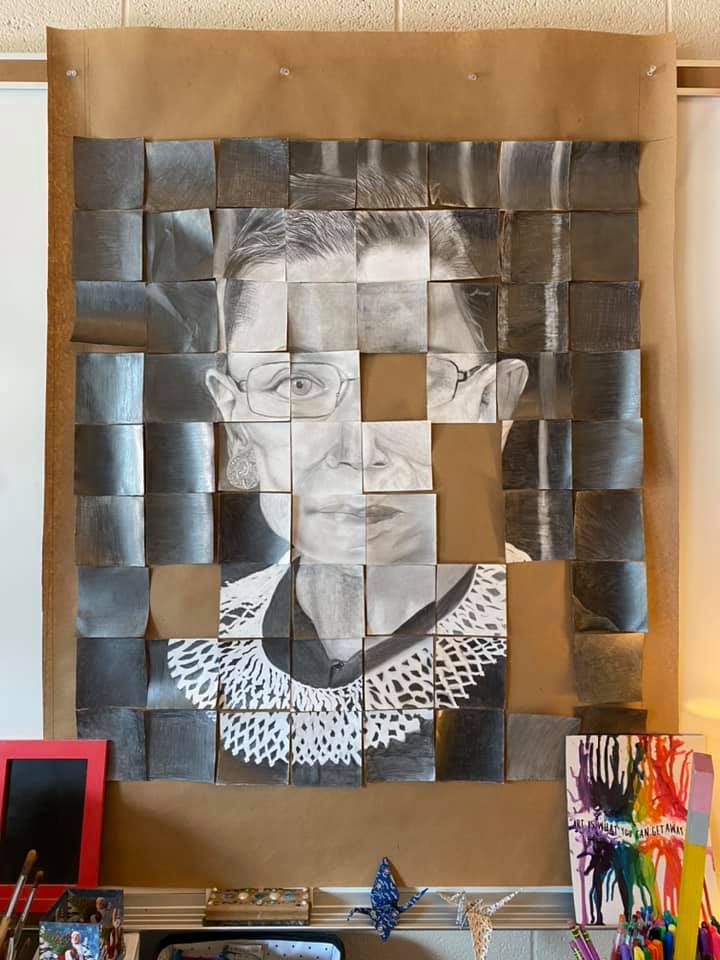Let’s talk gridding for a moment. Grid drawing is a staple of the art room. Some love it, some hate it, and I am here to say your feelings are valid no matter where you fall on the spectrum. I did grid drawings in My Art I classes earlier in my career and moved away from them, focusing on more observation-based drawing lessons. I returned to it when teaching students who I felt desperately needed to build confidence because grid drawings can build real confidence in beginner students. So, let us dive into some Q&A about best practices with grid drawing.
Where can I find a website to upload a photograph, grid it, and then scramble it into a “mystery drawing” for your students to solve individually or as a group?
Check out these two:
Block Posters
PicScrambler
In the photo below, art teacher Emily Michelle did this collaboratively with her art class.

Is there a shortcut for gridding the photo?
Yes! gridtoolonline.com
Another option is to use premade grids on glass or heavy plastic. You can buy transparency sheets that can go through a copier to print different-sized grids to place on top of a photo. Also, grid drawing isn’t always all or nothing. Using tools like you can help students apply some grinding concepts to freehand drawing using tools like this one.
How do I deal with visible lines at the end of grid drawing? Is there an easy way to use it and be able to erase the lines at the end?
You can employ a few strategies to avoid or minimize the grid lines, but you need a plan from the start. Some teachers have the students do a rough draft with the grid on newsprint and then use light tables to transfer onto nicer drawing paper for the value study.
Another strategy is to teach students to draw the grid lightly. It should help them get their bearings and ensure the proportions are correct. After they finish the line drawing, have students refer to the photograph without a grid.
Yet another approach is to have students use a 2H pencil. That way, the grid lines are light and will erase easily or fade into the drawing as they shade.
Another trick of the trade is to have students grid darkly and then turn their paper over, put another piece of white paper under their paper, and they can easily see their grid lines through. Similarly, have students draw the grid with a Sharpie marker on one sheet of paper and paperclip it under their drawing paper. They can see the lines without needing to erase them, and student can reuse their Sharpie grid for other drawings.
Do I need to teach grid drawings?
No, it is a staple of some teacher’s art programs, but you do not need to do them! There is more than one way to approach drawing, and grid drawing is just one. I think of grid drawing as the equivalent of training wheels when you are learning to ride a bicycle. But the downsides of grid drawing are that it can be a very long and involved process and takes patience. It also can involve a lot of math. You have to do a lot of preparation for grid drawings.
Gridding typically involves working from a photo, so it’s important that students learn that simply copying a 2D photo is not the end goal of drawing. Copying a photo leaves out much of the real magic and work of representational art-making: observing and selecting what will be shown. You might have students take their photos to work from and not simply rely on another artist’s image. Ultimately, it’s important to use grid drawing as a skill builder and work towards observation from life.
So, why teach grid drawing?
Grid drawings give students confidence. It also helps teach them to trust the process of art making. Even students who feel they “can’t draw” or aren’t “talented” walk away with drawings they are proud of when using the grid method. For early drawers, it’s a good way to train the eye on proportions and spatial relationships without feeling intimidating. You can then ease into observational drawing with viewfinders. While some artists see grids as “cheating,” others point out the rich history of grid drawings in art history. If great artists like Van Gogh, DaVinci, and Escher used a grid, why not our students?
Speaking of art history, what artists can I show my students?
A good reference for teaching the history of grids in art can be found HERE.
Other artists include:
Arinze Stanley Egbengwu
Kehinde Wiley
Darius Dennis (mural artist)
Alan Shields
Sean Scully
Mary Heilmann
Donald Judd
Bernd & Hilla Becher
Frank Stella
Agnes Martin
Chuck Close
Sol Lewitt
Leonardo Da Vinci
Vincent Van Gogh
Edward Degas
Albrecht Durer
Michelle Grabner
Lynne Golob Gelfman
Kenneth Noland
Alan Shields
Are there alternatives to the square grids?
Yes! Try the Triangular Grid Technique; find instructions HERE.
Some other resources you may want to check out:
A basic approach to grid drawing can be found in this excellent YouTube Video.
I also recommend this nice presentation on grid drawing found on Prezi.
Do you have any tips on grid drawing to share? Do so in the comments.




